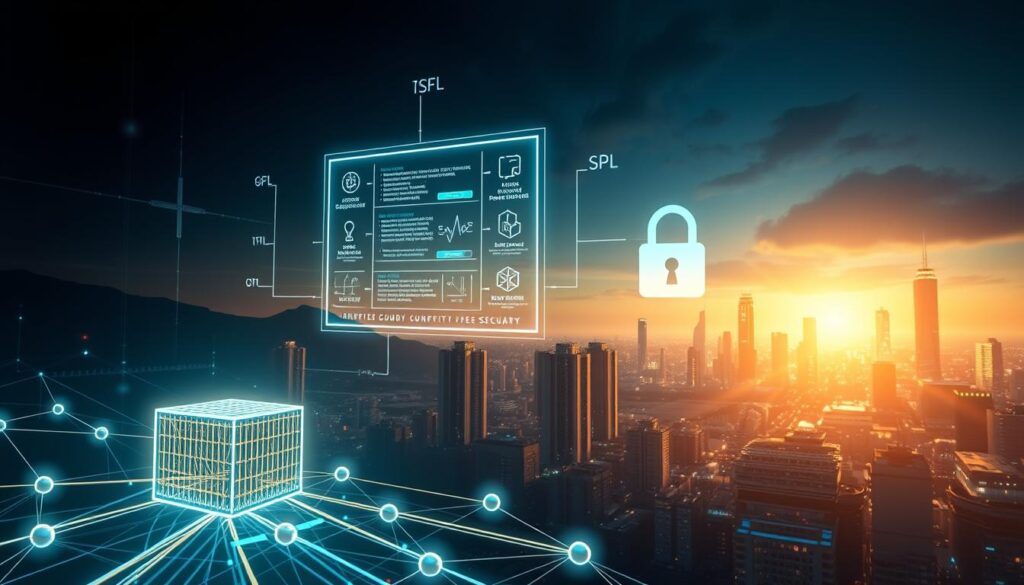Blockchain technology is reshaping how we interact with value. Imagine a future where physical items like buildings, rare art, or even patents exist as digital entries secured by decentralized networks. This shift unlocks unprecedented access to markets once reserved for elite investors.
By converting tangible and intangible items into digital tokens, blockchain creates transparent ownership records. Investors can trade fractions of high-value items through secure platforms. Experts predict this approach could redefine global economics, with trillions in value migrating to blockchain systems by 2030.
Traditional markets face challenges like slow transactions and limited accessibility. Tokenized systems streamline processes while opening doors for smaller investors. McKinsey research highlights how this innovation might boost global GDP by billions, signaling a new era of financial inclusivity.
Key Takeaways
- Blockchain converts physical and financial items into tradeable digital units
- Market analysts project trillion-dollar growth in tokenized systems by 2030
- Smaller investors gain access to high-value markets through fractional participation
- Decentralized networks improve transaction speed and transparency
- Global economic expansion could accelerate through increased asset liquidity
Introduction to On-Chain Asset Tokenization
Modern finance is undergoing a radical transformation through digital representation of value. This shift allows everything from skyscrapers to patents to exist as verifiable entries on decentralized ledgers. At its core, this revolution hinges on converting tangible and intangible items into digital tokens that mirror their real-world counterparts.
Defining Asset Tokenization and Its Impact
The process starts with professional valuation, followed by dividing items into standardized units. These units become blockchain-based certificates, enabling 24/7 trading on specialized platforms. One commercial property could simultaneously belong to thousands of global participants through this method.
The Evolution From Traditional to Digital Ownership
Historically, high-value markets demanded six-figure commitments. Digital alternatives now let individuals claim stakes as small as $100 in premium ventures. Art collectors and property developers alike use this system to attract diverse backers while maintaining control.
This approach doesn’t erase physical ownership—it enhances it. Legal frameworks ensure each token corresponds to specific rights, creating hybrid models where digital convenience meets real-world value. Marketplaces now handle transactions in minutes instead of months, reshaping how we build wealth.
Understanding tokenization, real-world assets, fractional ownership, liquidity
https://www.youtube.com/watch?v=CHPYGjE6NCs
Digital markets are rewriting the rules of asset management through programmable value exchange. This shift introduces mechanisms that let individuals engage with premium ventures previously locked behind institutional gates. Shared stakes in skyscrapers or rare collectibles now flow through decentralized networks, powered by cryptographic verification.
Key Concepts and Terminology
Fungible units represent identical value portions, like shares in a commercial property fund. Unique items use non-replaceable certificates to preserve their individuality—think vintage cars or patent rights. Both formats enable instant transfers across borders, with settlement times measured in seconds.
Enhanced tradability transforms static holdings into dynamic portfolios. A 2023 State Street survey revealed 45% of institutions cite awareness gaps as adoption hurdles. Yet platforms already demonstrate how round-the-clock trading breathes life into dormant capital.
How Digital Tokens Enable Broad Market Participation
Entry thresholds crumble as systems accept micro-investments starting at $50. A Tokyo-based engineer can now own a slice of a Miami high-rise. Transparent ledgers display every transaction, building confidence through verifiable histories.
Global pools of capital form as platforms erase geographic restrictions. Morning commuters in Chicago trade vineyard stakes with night-shift workers in Sydney. This 24/7 accessibility redefines what it means to build wealth in interconnected markets.
Blockchain Technology: The Backbone of Tokenized Assets

Decentralized systems are revolutionizing how we manage value through unbreakable digital frameworks. At the core of this shift lies blockchain technology, which creates tamper-proof records for every exchange. This innovation eliminates reliance on centralized authorities while enabling real-time verification across borders.
The Role of Smart Contracts in Automation
Self-executing agreements called smart contracts power this ecosystem. They automatically transfer ownership when payments clear or revoke access if terms lapse. For example:
| Platform | Use Case | Speed | Security Features |
|---|---|---|---|
| Ethereum | ERC-20 tokens | 15-30 sec | Proof-of-Stake |
| Hyperledger | Enterprise solutions | Instant | Permissioned access |
| Corda | Financial services | 2-5 sec | Digital signatures |
These tools handle complex tasks like royalty payments without human oversight. A Deloitte study found organizations using smart contracts reduce processing costs by 35%.
Enhancing Transparency and Security in Transactions
Every exchange leaves a permanent trail visible to authorized participants. Multi-signature wallets require three approvals for high-value moves, while encryption shields data during transfers.
“Blockchain’s layered protection mechanisms make it 58% harder to breach than traditional databases,” notes a 2024 IBM security report.
Emerging layer-2 networks like Polygon cut fees by 80%, letting smaller investors participate. This balance of security and accessibility builds global trust in digital systems—critical for mainstream adoption.
Fractional Ownership: Transforming Investment Accessibility

Premium markets are becoming democratic playgrounds through shared participation models. Digital certificates now let hundreds of backers co-own skyscrapers, rare paintings, or vintage cars with minimal commitments. This shift turns exclusive opportunities into collaborative ventures powered by programmable equity.
Lowering Barriers for High-Value Asset Investment
Entry points once requiring six-figure sums now start at $100. A New York office tower might have 3,000 global partners, each contributing small amounts. Automated platforms handle legal agreements and profit splits, cutting administrative costs by 40% according to Roland Berger data.
Investors diversify risks by spreading funds across multiple properties or collectibles. A teacher in Texas could hold stakes in a Paris gallery, Singapore warehouse, and California vineyard simultaneously. This approach reduces reliance on single ventures while building balanced portfolios.
Diversifying Asset Classes Through Digital Shares
Markets once dominated by institutions now welcome retail participants. Platforms list everything from patents to luxury yachts, each divided into standardized units. Owners earn through rental income, resale profits, or management fees tied to asset performance.
Recent projects show tangible results. A Dubai hotel tokenized in 2023 attracted 1,200 investors who earned 9% annual returns. Such models prove shared stakes can unlock value while maintaining operational control for original holders.
Regulatory, Security, and Interoperability Challenges

Global adoption faces critical hurdles as digital systems intersect with legacy frameworks. Three core issues dominate discussions: shifting compliance demands, evolving cyberthreats, and fragmented technical infrastructure.
Navigating Regulatory Uncertainty and Compliance
Lawmakers struggle to classify digital certificates under existing rules. The SEC recently labeled 68 crypto tokens as unregistered securities, while the EU’s MiCA framework creates new compliance layers. Cross-border projects face conflicting anti-money laundering protocols across 130+ jurisdictions.
Mitigating Cybersecurity Risks in Tokenized Ecosystems
Hackers stole $3.8 billion in 2022 through phishing and smart contract exploits. Solutions like hardware wallets and third-party audits reduce vulnerabilities. “Multi-signature systems cut theft attempts by 73% last year,” confirms Chainalysis’ 2023 crime report.
Ensuring Interoperability Between Diverse Blockchain Platforms
Assets on Ethereum struggle to interact with Solana or Cardano networks. Standardized protocols like ERC-721 enable cross-chain transfers, but 44% of platforms lack compatible bridges. Polkadot’s parachain model shows promise for seamless value movement.
Industry groups now push for unified management standards to ease these challenges. While progress accelerates, harmonizing global systems remains a multi-year endeavor requiring coordinated effort.
Real-World Applications: From Real Estate to Art
Concrete examples demonstrate how digital certificates reshape traditional markets. Deloitte forecasts real estate tokenization will surge from $0.3 trillion to $4 trillion by 2035. Figure Technologies exemplifies this shift, processing $13 billion in home equity loans through blockchain systems in 2023 alone.
Tokenization in the Real Estate Industry
Major projects like Canada’s 960-unit Champfleury development prove the model’s viability. T-RIZE Group’s $300 million deal lets investors trade stakes in this residential complex like stocks. 24/7 global trading replaces months-long paperwork, with settlements occurring in minutes.
Private funds are accelerating adoption too. Tokenized property portfolios could reach $1 trillion within twelve years, offering retail investors access to premium commercial buildings. “This isn’t just about efficiency—it’s about rewriting wealth-building rules,” states a Deloitte blockchain analyst.
Expanding to Art, Licenses, and Other Tangible Assets
Masterpieces once locked in vaults now have digital twins. A 2023 initiative divided a Picasso painting into 10,000 shares, traded globally through secure platforms. Collectors earn from exhibition fees and eventual sales while retaining physical control.
Licensing markets follow suit. Music producers tokenize royalty streams, letting fans invest in hit songs. Patent holders use similar models to monetize innovations faster. Even cargo ships and luxury watches now have blockchain-based certificates, blending physical value with digital flexibility.
Future Trends and Market Growth Potential
Financial landscapes are poised for seismic shifts as digital innovation accelerates market evolution. Analysts project radical changes in how value circulates globally, with decentralized systems unlocking untapped economic potential.
Market Forecasts and Economic Impact Predictions
McKinsey research suggests digital certificates could represent $4 trillion in value by 2030. This growth stems from streamlined processes that boost market efficiency—settlement times drop from days to minutes while operational costs plunge 40%.
| Technology | Application | Efficiency Gain |
|---|---|---|
| AI Valuation Models | Real-time pricing | 40% faster |
| IoT Sensors | Asset monitoring | 35% cost reduction |
| Predictive Analytics | Risk assessment | 28% accuracy boost |
Global GDP could rise $2.1 trillion through enhanced capital flow, according to World Economic Forum models. “Automated systems will slash administrative overhead by 60% within five years,” predicts Franklin Templeton CEO Jenny Johnson.
Innovative Technologies and Evolving Investment Strategies
Next-gen tools enable dynamic portfolio management. Algorithmic trading bots now execute cross-market strategies 24/7, while smart contracts automate profit distributions. Institutional investors combine these approaches with traditional holdings for balanced exposure.
Emerging business models like peer-to-peer lending platforms demonstrate the technology’s versatility. Early adopters report 50% faster capital deployment compared to conventional methods, creating competitive advantages in crowded markets.
Conclusion
Digital ownership models are redefining how value circulates in global markets. By converting physical and intangible items into tradable units, blockchain systems unlock streamlined capital movement and democratized participation. Investors gain access to premium ventures through secure platforms, while creators tap into borderless funding pools.
The true power of this shift lies in its scalability. Reduced administrative costs and automated compliance checks make markets more efficient. A 2024 Goldman Sachs report notes that digital certificates could slash transaction fees by 60%, accelerating adoption across industries.
Emerging frameworks will shape tomorrow’s opportunities. As regulations mature, expect innovative portfolio management strategies blending traditional and token-based holdings. Early adopters already see rewards—like instant settlements and 24/7 trading windows.
This evolution isn’t about replacing physical systems but enhancing them. When paired with robust security protocols, digital ownership creates a bridge between established markets and next-gen financial tools. The result? A more inclusive economic ecosystem where participation knows no boundaries.
FAQ
How does blockchain improve transparency for asset ownership?
Blockchain creates an immutable ledger that records every transaction publicly. This ensures traceability and reduces fraud risks. Platforms like Ethereum and Polygon use decentralized networks to verify ownership changes without intermediaries.
Can digital tokens represent physical items like art or property?
Yes. Companies like Maecenas and RealT tokenize paintings or real estate, converting them into tradeable digital shares. These tokens act as proof of partial ownership, backed by smart contracts that automate compliance and transfers.
What industries benefit most from fractionalized investments?
High-value sectors like commercial real estate (e.g., platforms like Republic) and fine art (via Masterworks) gain traction. Even niche markets, such as rare collectibles on OpenSea, use fractionalization to attract smaller investors.
Are tokenized assets compliant with financial regulations?
Compliance varies by jurisdiction. Projects like Securitize work with regulators to align token offerings with frameworks like SEC guidelines. However, global standards are still evolving, requiring legal expertise for cross-border transactions.
How do smart contracts reduce operational costs?
Automated processes eliminate manual paperwork and middlemen. For example, IBM’s Hyperledger streamlines supply chain management by executing agreements instantly, cutting administrative expenses by up to 40% in some cases.
What risks exist in trading tokenized securities?
Cybersecurity threats, like exchange hacks, remain a concern. Platforms such as Fireblocks offer institutional-grade custody solutions. Market volatility and regulatory shifts also pose challenges for long-term stability.
Will traditional banks adopt blockchain for asset management?
Major institutions like JPMorgan and Goldman Sachs already explore blockchain-based solutions. Their platforms, such as Onyx, aim to enhance settlement speed and reduce friction in capital markets through distributed ledger tech.


